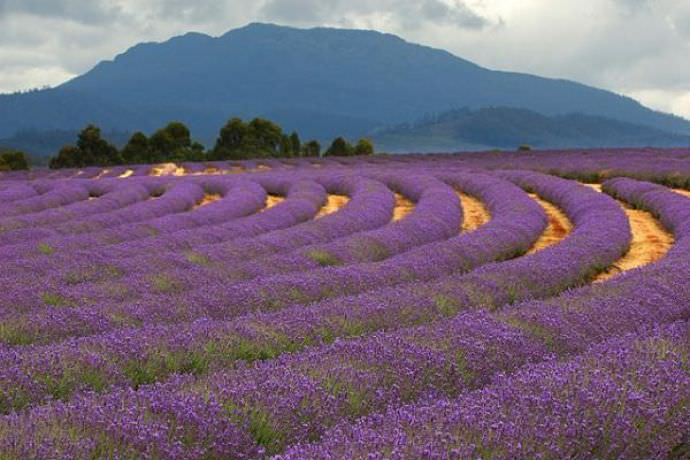
When to plant lavender in the ground in spring. Lavender - planting and care in the open field, preparation for a sachet.
In garden culture, the following types are considered the most popular:
- Lavándula angustifólia, known as real lavender, English lavender, spikelet lavender, narrow-leaved lavender. In most cases, it is this type of plant that is meant when it comes to lavender. In height and width, this shrub reaches 1 m, with the exception of dwarf varieties that grow no higher than 30 cm. Flowering time is June-July.
The most popular varieties are Alba (white), BeechwoodBlue (purple blue), Rosea (pink), Gem (dark purple), Hidcote (dark purple), MelissaLilac (purple large-flowered), Munstead (purple blue), NanaAlba (white dwarf), LittleLottie (pale pink dwarf) and others.
- Lavanludalatifolia, or Lavender spikelet, Lavender broadleaf. Distinctive features this type of plant is considered to have a stronger aroma, as well as wearing on the stem not one, like narrow-leaved lavender, but three inflorescences.
- LavanludaintermediaEmeric (Dutch lavender, or Lavender hybrid, or Lavandin) is a natural hybrid of the two types of lavender described above. It is less cold resistant, which is why it is most popular in the gardens of southern and central Europe. Lavender Dutch is a large plant, reaching a height and width of up to 2 m, with large and long inflorescences and curved peduncles. The flowering time of this plant comes a little later than that of narrow-leaved lavender - in July.
The following varieties are especially popular: Alba (white), Grosso (lilac-violet, having large flowers), Sawyers (light purple), ArabianNight (blue, dark purple) and RichardGray (compact dark purple).
- Lavanludapedunculata, or petiolate lavender, is an ornamental species of this plant with unusual colors and strong smell. The flower stalks of the shrub are usually no more than 50 cm, and the flowers have a bright purple color. Common lavender is common in Spain, Portugal, Turkey and Morocco, in Russia it is usually grown in pots.
- Lavanludastoechas, known as Stahad Lavender, can reach 30 to 100 cm in size. This species blooms earlier than all the others - March - June, and at the end of summer the second phase of flowering is possible.
- Lavanludadentata, or serrated lavender, is a compact subshrub with large flowers and soft, rugged, silver-colored leaves. Due to the fact that this type of lavender is quite thermophilic, it is grown mainly indoors in pots.
Reproduction of lavender using stem layering
This method of reproduction is considered the simplest: one of the branches of the shrub is laid horizontally, completely covered with soil, and a load is placed on top. It usually takes a few months for a cutting of lavender to take root and be able to grow on its own.
After the formation of a lump of roots, the layers must be carefully cut off with a sharp knife, and the cut point should be sprinkled with crushed coal, thereby protecting the plant from decay processes.
It is also possible to propagate by rooting individual, for example, broken branches or one-year-old woody cuttings: it should be deepened 2-3 cm into loose soil, covered with a film, not forgetting to regularly moisten the soil. As a rule, the cutting takes root quickly enough, after which it can be safely transplanted to the chosen place.
Growing lavender from seeds
Before planting, the seeds must be hardened and stratified. Within a month, they should be kept in the lower compartment of the refrigerator, then mixed with river sand and, systematically moisturizing, kept in this form for another month.
Lavender seeds should be planted along with sand, covering the top with a not very thick layer of soil.
When planting seeds, you need to be prepared that the flowering of lavender will have to wait about one or two years, since in the first seasons the plant will give all its strength to building up the root system.
Place for planting lavender in open ground
When planting a plant in a garden or in a flower bed, it is recommended to choose areas that are well exposed to sunlight. Lavender can also take root in the shade, but in this case you should not expect long and abundant flowering.

The name Lavender (lavare) appeared in the Middle Ages, it means to clean or wash. This plant has been known since Ancient Greece and Rome, where it was popular with doctors, nobles and ordinary people.
Lavender in Southern Europe has long been known as a healing, spicy plant. Previously, this plant was used in almost every home for medicinal purposes and as a healthy and tasty spice.
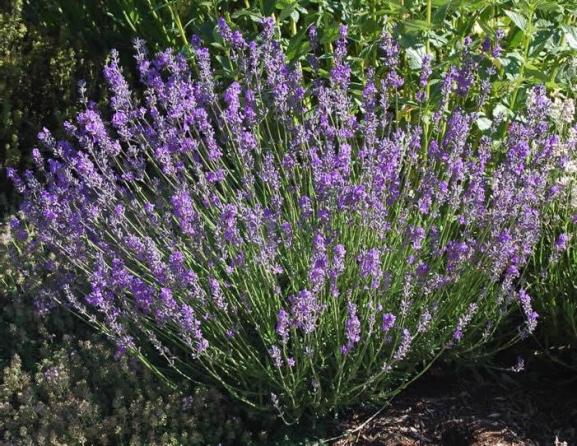
Lavender is a drought-resistant evergreen subshrub of the Lamiaceae family.
It is grown on alpine hills, rockeries, gardens, in tubs on terraces, in pots on the window. Lavender bushes decorate paths in parks and gardens. In many countries, it is grown on an industrial scale and used in medicine and cosmetology.
Lavender is found in the wild in the mountainous and hilly regions of Arabia, in the Mediterranean countries, in the Canary Islands, in India, in North and East Africa. The plant is cultivated in the Kuban, in the Crimea, Central Asia, Moldova, Ukraine, North Africa, southern Europe.
Lavender, despite being an evergreen, has a dormant period. At this time, the bush sheds part of the foliage. Branches are replaced every 7-10 years or after severe freezing. To increase flowering for bushes, annual pruning is performed. If the bushes are not cut off, the decorative effect is lost, since the lower part is exposed, and the upper part is pulled out.
A lavender bush grows up to 30-100 centimeters, some varieties reach 2 meters.
Stems branched, numerous. The leaves are narrow, linear-obtuse, the edges are wrapped. Color grey-green or green.
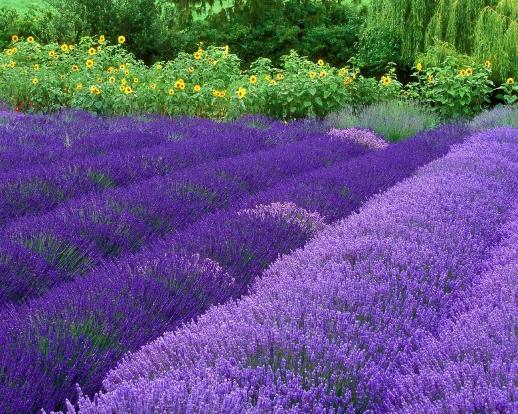
Inflorescences are collected from above, intermittent, spike-shaped. The flowers are blue-violet, white or pink, collected in false rings of 6-10 pieces. Flowers bloom from June to August.
The fruits are dry, consist of 4 one-seeded dark brown nuts. 1 gram contains up to 1000 seeds.
After planting in the ground, the bush blooms in the second year. The collection of leaves and stems is done during flowering.
Flowers are picked from the end of June, when the fragrance of the flowers is stronger.
Lavender in dried form is used in the kitchen in medicine, cosmetology. The leaves are used as spices. Lavender has a bitter, spicy-tart taste and a pleasant, spicy aroma. Lavender is widely used on the Mediterranean coast (in Italy, Spain, Corsica, France).
When picking flowers, flower shoots are cut and formed into bunches. They need to dry quickly. From dry twigs, you can easily collect flowers. Dry flowers, leaves and twigs are used as a spice. Freshly cut leaves can also be used as a seasoning.
Types and varieties of lavender with a photo
The lavender genus includes 47 species and 7 hybrid species of this plant. Only 28 species are cultivated and only a few differ in their useful properties.
AT traditional medicine only a few species of this plant are used: broad-leaved lavender, serrated lavender, spikelet lavender (medicinal), narrow-leaved lavender, hybrid lavender.
Lavender jagged characterized by soft silvery or gray-green leaves. Purple colored flowers.
The most popular variety of this plant is Royal Crown - purple.
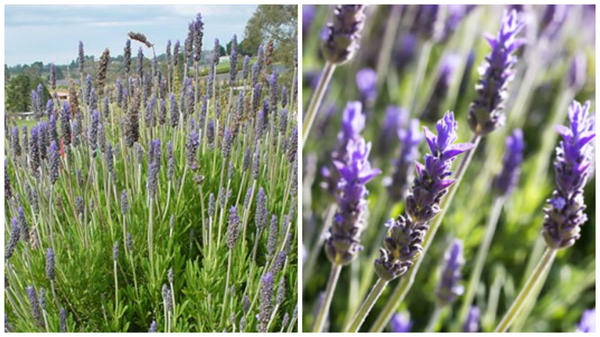
Serrated lavender, Royal Crown cultivar
lavender broadleaf is an evergreen shrub up to 1 meter in height. Leaves are lanceolate. Flowers blue-grey.
Popular varieties of the species:
- Tiara with large blue flowers;
- Papillon - flowers in the form of butterflies, pinkish-purple color;
- Regal Splendour - dark purple.
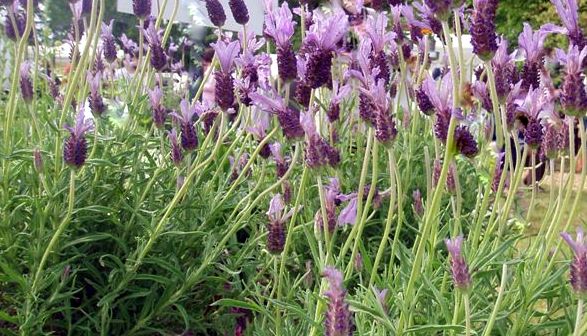
Lavender Papillon
Lavender angustifolia (English) grows up to 50-70 centimeters in height. Semi-shrub strongly branched at the base. Lignified branches semilying. Young branches are upright.
The leaves are entire, 2-6 centimeters long, the edges are wrapped to the bottom, linear, lanceolate or oblong-lanceolate, the lower part has a glandular edge. The color of young foliage is gray, old leaves are green.
Inflorescences atypical, apical, spike-shaped. The color of the flowers is dark, blue-violet. The fruits consist of 4 nuts in a cup. Flowering July - August. This type of lavender is suitable for growing in regions with a cool climate.
In culture, varieties of this species with a different color are known, these are:
- Gem - dark purple flowers;
- Alba - white;
- Munstead with purple-blue flowers;
- Rosea - pink flowers.
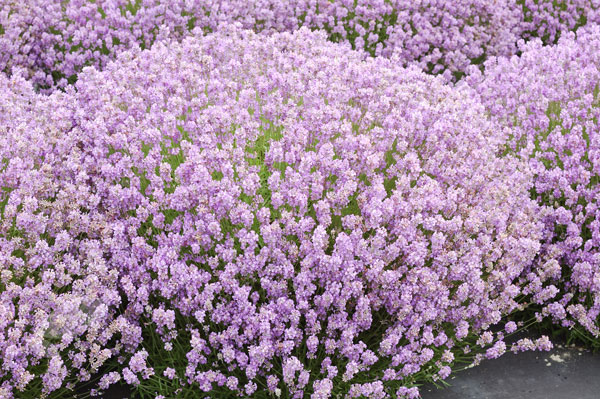
Lavender angustifolia Rosea
It is a low growing evergreen shrub. The plant is cold tolerant. The bush consists of a large number of branched woody stems that begin their growth from the root. Lowered, tetrahedral stems grow from 30 to 60 centimeters.
The foliage is linear, pubescent, sessile. The coloration is greyish. The location is opposite. When crushed, the leaves emit a spicy aroma. The root system is powerful, up to 2 meters long.
The flowers are medium, bisexual, bluish-violet. Bracts contain 3-6 flowers. Flowering lasts from July to August.
The plant is a hybrid. When propagated by seeds, the lavender of this species produces many different forms that are different from the mother plant. For industrial purposes, it is cultivated by layering and cuttings.
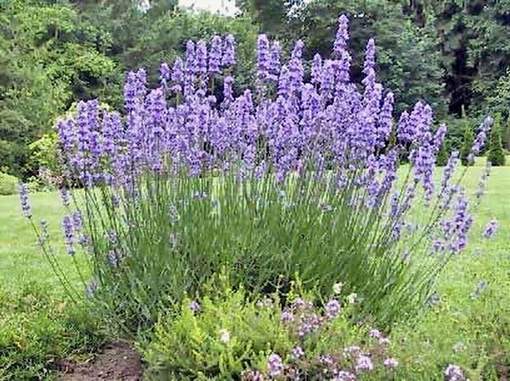
Lavender spikelet, French or officinalis
Hybrid Lavender (Dutch, Lavandin) is a natural sterile hybrid of broadleaf and English lavender. Differs in large inflorescences and narrowed silvery leaves. The height of the bush reaches 2 meters.
Known varieties:
- Olympia with dark purple flowers;
- Grosso - purple;
- Arabian Night - dark purple flowers;
- Seal - blue-lilac flowers.
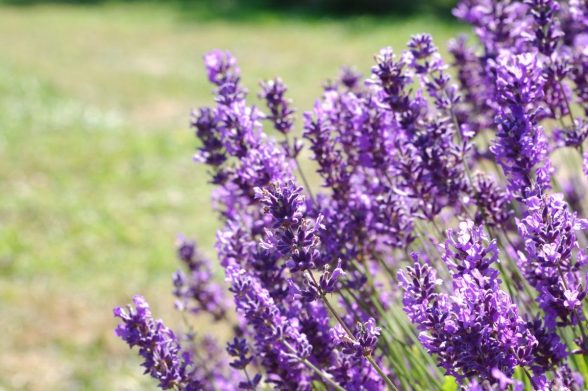
Lavandin, Lavandula hybrida, Lavender hybrid
Also, the best varieties include:
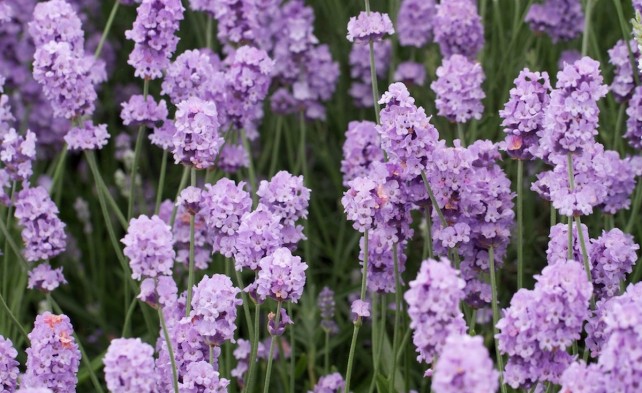
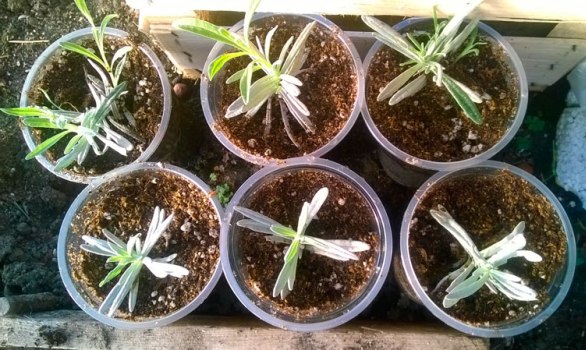
This useful herb can be grown in your garden or vegetable garden. The easiest way to propagate lavender is the seedling method. Seedlings are grown in low boxes with drainage holes at the bottom. Instead of boxes, you can take containers with a lid, pots. Seeds undergo stratification (cold treatment) before sowing.
Then the seeds are sown in the prepared soil. The land can be bought ready-made or made at home.
After 2-3 main leaves appear on the seedlings, they are seated in separate pots. Closer to summer, lavender can be transplanted into open ground.
Some varieties are suitable for growing in pots and are taken out in the summer to fresh air, and in winter they grow on a windowsill or balcony. In this case, the bush remains evergreen all year round.
When planting in the ground, the roots of plants are cut a little, this stimulates the growth of the plant.
Seedlings grown indoors easily take root in open ground, as they are more hardy.
When to sow seedlings
Sowing seeds in boxes is carried out in February - March. Sowing time depends on the region. The warmer the climate, the earlier you can start growing seedlings. In regions with a temperate climate, on the contrary, it is better to sow later, with the expectation that seedlings will be planted in late May or early June, after the last frost has passed.
Sowing lavender seeds in open ground is carried out in mid-May. Seeds are sown according to the scheme 30 by 30 centimeters.
In warm winters, seeds can be sown directly into the ground for the winter. The area with crops is covered with a layer of snow or covering material, and in spring, in May, young plants appear.
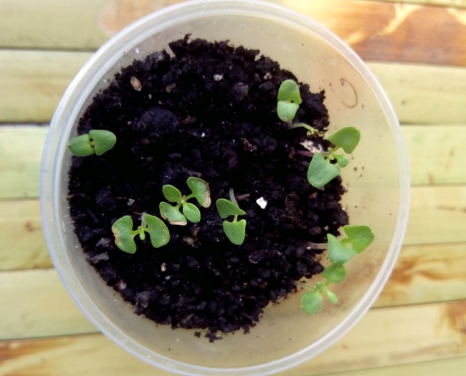
Seeds are best bought in early winter or late autumn. Lavender quickly loses its ability to germinate. When choosing seeds, you need to pay attention to expiration dates.
Two months before sowing, the seeds are placed in a damp cloth and kept for 2 days at room temperature. Then the seeds are moved into a bag and laid out on the top shelf of the refrigerator.
Also, seeds can be mixed with sterilized wet sand and placed in a cold place, both methods are quite effective.
Seeds remain cold until sowing. To improve germination, the seeds are placed in a solution of Epin or succinic acid.
In February - March, seeds can be sown in prepared soil. The soil can be taken ready-made or made independently.
On 3 parts of soddy land, 2 parts of humus are taken, part of the washed dry river sand. The mixture is stirred and sieved. Fine perlite, vermiculite can be added to the soil.
The finished mixture is calcined in the oven at a temperature of 110 degrees and spilled with a weak solution of potassium permanganate. A drainage layer of river sand or small pebbles is poured at the bottom of the tank.
Seed stratification: video
Sowing and caring for seedlings
Seeds are mixed with sand (if stratification was carried out without it). Sowing is done using a sheet of paper folded in half or in the form of an envelope. Seeds are distributed in a thin stream.
In the presence of snow, you can lay out a thin layer of snow and pour seeds on it, places where a lot of seeds will be scattered can be distributed over the surface.
For a more rare sowing, you can use a moistened toothpick.
Seeds are buried 2-3 mm into the ground. A thin layer of washed and dried river sand is poured on top. The soil is sprayed with warm water (from a spray gun) and covered with a film or a transparent cover, glass.
The best place to place a container with seeds is a sunny, cool place with an air temperature of 15-22 degrees.
After germination, the film is removed. Removal is not done immediately, but gradually. The plants need to get used to the cooler, drier air in the room. First, the shelter is removed for 10 minutes, then for 20 and beyond.
Seedlings with 2 main leaves are planted in separate pots.
For better growth, plants need additional illumination with a fluorescent lamp. The air during cultivation should not dry out. Next to the seedlings, if necessary, a container with water is installed.
Watering is carried out after the earth dries up, excess moisture is drained from the pan. Lavender does not like dampness and may die if moisture accumulates.
Top dressing is done half a month before transplanting into the ground. For top dressing, you can take any mineral fertilizers with an admixture of nitrogen.
By the end of May, the seedlings will get stronger and you can start planting plants in open ground.

Seedlings in the ground can be planted from late May to early June. The weather should be warm and sunny.
Lavender is grown in high, sunny, wind-sheltered areas. In one place, the bush can grow 18-25 years. For protection from the wind, it is best to choose southwestern or southern, well-lit slopes.
Lavender is not demanding on the soil, but still has its own preferences. The soil should be light and moisture permeable. Damp, dense, clay soil is not suitable for growing. The best option is humus lime soil. The close occurrence of groundwater or the accumulation of moisture in the lowlands is detrimental to plants.
For better growth, fine gravel and washed river sand are added to the soil.
Before planting, a bucket of compost or humus, 50 grams of superphosphate, 25 grams of potassium salt are introduced into the soil per square meter. The soil must be alkaline, if necessary, the earth is limed to a pH of 7-7.5. For liming, you can use slaked lime, bone meal, wood ash.
Seedlings are planted according to the scheme 70 to 50, where 70 centimeters is the distance between rows, and 50 is the gap between plants. For bulk varieties, the distance increases to 55 by 100 centimeters.
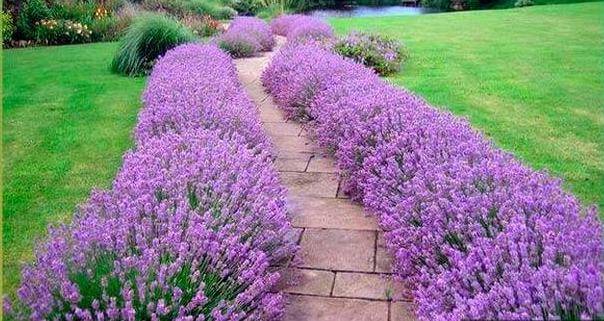
Lavender care includes watering, weeding, loosening, top dressing and pruning.
Watering is done with a watering can with a nozzle, every day, in the morning or in the evening, from the time of planting until the end of summer. Water for irrigation should be warm and settled. Moisture should not stand, the soil should be slightly moist.
In dry times, you need to ensure that the ground under the plants does not dry out. Plant mulch is distributed between the lavender bushes to conserve moisture. If the summer is rainy, water as needed and move the mulch away from the bushes to prevent rot.
If mulching is not used, after each watering, the aisle between the lavender should be loosened to supply oxygen to the roots.
At the beginning of summer, nitrogen-containing fertilizers are applied to the soil. Until the beginning of August, organic fertilizers (humus) or potassium salt, ammonium nitrate and superphosphate are applied. At the same time, nitrogen is excluded, otherwise the green part will grow, and flowering will be poor. From August, feeding stops.
Pruning bushes allows the bush to grow faster. Once every 7 years, a complete pruning of branches is performed.
Lavender is rarely affected by pests and diseases. Plants under unfavorable conditions can be damaged by gray mold, pennitsa, aphids, rainbow beetle, two-bladed agalmatium. When diseases and insects appear, plants are treated with protective preparations (pesticides and insecticides).
Removal of weeds and preventive treatment of bushes and soil allows you to protect plants and simplify care.
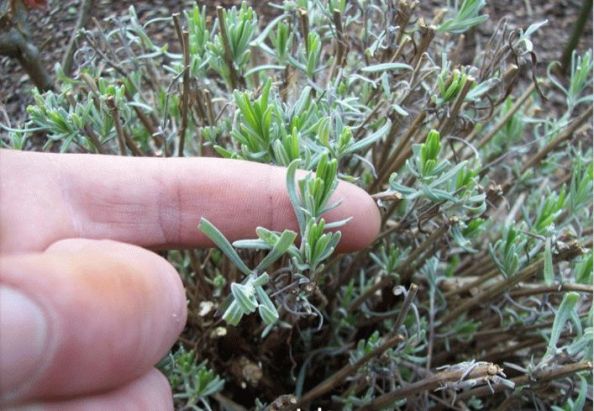
Lavender is propagated by seed, division of the bush, layering and cuttings. Seed propagation is used in the cultivation of varietal plants. Hybrids are mainly propagated by cuttings, layering, dividing the bush. With seed propagation, varietal characteristics are lost.
When cutting the above-ground part of the bush, you can get a large number of seedlings. The cut bush is spudded. After a while, up to 200 new shoots appear, which are transplanted to a new place.
Instead of cutting, you can do this: stronger branches lean towards the ground, sprinkle with soil. When sprouts appear, the seedlings are planted in new places.
Cuttings are taken from adult bushes. Stems up to 10 centimeters long are cut from the mother plant. Cuttings are planted in cold greenhouses according to the scheme 4 by 5 centimeters, to a depth of 5 centimeters. In May, they can be planted on the site or in the nursery. In the second case, the plants are planted in the main place in the fall.
Planting seedlings occurs according to the scheme 50 by 70 or 55 by 100 centimeters (depending on the variety and place of growth of lavender).
Lavender - growing, planting, propagating, planting lavender from seeds in the ground: video
Preparing for winter
In regions with a cool climate, only narrow-leaved lavender can winter in open ground.
Other species are thermophilic and freeze out during winters with little snow.
Bushes are loosely covered with spruce branches or any non-woven material. In winters with little snow, snowdrifts are thrown over the plants.
In spring, snow is removed from the bushes, which accelerates the warming of the soil and accelerates the awakening of the root system.
Bushes are pruned to reduce the evaporation area. This protects the plants from freezing.
When pruning, the shoots are shortened by a third of the length. In warm regions, pruning is done in autumn, in temperate regions in spring.
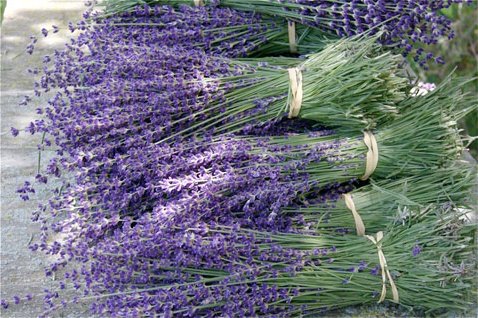
Lavender is an essential oil plant.
For medicinal purposes, stems, leaves, flowers, essential oil from the plant are used. Most of the oils are found in flowers, their leaves and stems are an order of magnitude smaller.
Lavender flowers contain 3 percent essential oil. It contains about 50 percent linalyl acetate. Up to 12 percent tannins. The oil also contains: bitter substances, lavandulol, coumarin derivatives, borneol, geraniol, amyl alcohol, free linalool, nerol, resins, cinnamic and valeric aldehydes.
Lavender has a calming, antidepressant, healing, antiseptic, anti-inflammatory, antispasmodic, choleretic and diuretic effect. The plant helps with palpitations, neurasthenia, neurosis, migraine, gastrointestinal colic, bronchitis, asthma.
Diuretic and antispasmodic action improves the condition in diseases of the renal pelvis, kidneys, bladder.
Lavender reduces gas formation in the intestines, relieves pain in the stomach and intestines. Tannins have a fixing effect and help with diarrhea.
The plant removes toxins from the body, improves the general condition of the body.
Lavender tea accelerates the treatment of flu, cough, helps with acute rheumatism, and allows you to normalize sleep. Therapeutic baths soothe, relieve tension, help with inflammatory processes in the female genital organs.
Essential oil has a bactericidal and antiseptic effect, is used in the treatment of purulent wounds, rashes, diseases of the female genital organs.
Lavender oil with the addition of alcohol helps with nervous disorders, migraines, irritability.
Medicine, lavender is part of gel preparations (medicinal teas, tinctures, aromatic alcohol).
Aromatic oil is used in cosmetology and perfume industry.
Lavender scent repels moths and mosquitoes.
Lavender is a very beautiful, fragrant plant that can decorate any garden or window sill, balcony. And the properties of the plant allow you to get not only aesthetic enjoyment of the type of plant and aroma, but also benefits.
Lavender, mountain lavender - how much sense in these simple words. Lavender is a very beautiful and fragrant plant. To admire its beauty during the flowering period, you can go to the southern countries, or you can make a small flower garden at home on the windowsill or grow lavender in your backyard.
Lavender has been known to mankind since ancient times. It is impossible not to fall in love with this plant at first sight, a delicate delicate aroma and a delightful shade of flowers make you stop and enjoy flowering endlessly. If you dream of admiring the beauty of this exquisite plant, we suggest that you familiarize yourself with the rules for growing lavender. It doesn’t matter if you are an experienced gardener or just starting to master the intricacies of this business, you can plant and grow lavender both on the windowsill and in your garden.
Types of lavender
Before we learn how to grow lavender, let's get acquainted with the types of this beautiful plant. There are more than 25 types of lavender in nature, but only a few are popular:
- English or narrow-leaved lavender. It is this plant that is the object of adoration. When we say, "Look how beautiful the lavender blooms!", that's English lavender. The plant reaches a height of up to 1 m in height, the leaves are narrow-leaved, like the flowers themselves. Lavender is unpretentious, not afraid of frost. Flowers can have a different color, from the traditional purple hue, to pink, purple, white and even blue. The aroma is very delicate and fresh, the flowering period is July. There are a lot of varieties of this type of plant, it differs in the shade of flowers, lavender varieties are called “Pink” (Rosea), “Blue with purple” (Beechwood Blue), “White dwarf” (Nana Alba) and so on.
- Lavender spikelet or broad-leaved. It has a stronger, more pronounced aroma than traditional lavender (narrow-leaved). It differs in that 3 inflorescences are located on one stem at once (English lavender has only one).
- The hybrid variety of lavender ("Lavandin") is a mixture of the above plant varieties. This lavender grows in southern and central Europe, in gardens and fields. It is not as resistant to cold, but is of great value as a medicinal plant. Lavender reaches a height of up to 2 meters, its leaves are long and narrow, the flowers are large. The flowering period of hybrid lavender is mid-July, a little later than narrow-leaved lavender blooms. A high-quality essential oil is obtained from this plant variety. The flowers of this variety of lavender can have different colors: blue, purple, lilac. The size of the flowers can also be different, from small to large.
- French or "Stehad" lavender is an ornamental cultivar with a long stem and bract. Shades of flowers can be very diverse (the result of many years of work of breeders). You can find whole plantations of lavender with green, white, burgundy, purple and traditional purple flowers. The smell of this variety of lavender is also very strong, but not as pleasant as that of English lavender. The flowering period is early, so that at the end of summer lavender can please with its flowering a second time. For central Russia, breeders recommend growing this plant variety in pots at home.
- Scalloped lavender is a small shrub with beautiful scalloped silvery leaves, large flowers and very fragrant. The flowering period of this plant is July. The plant loves heat and does not tolerate frost, so this variety of lavender is desirable to grow at home in pots.
- Velvet hybrid lavender - very beautiful plant with fragrant flowers and leaves of a shade of silver.
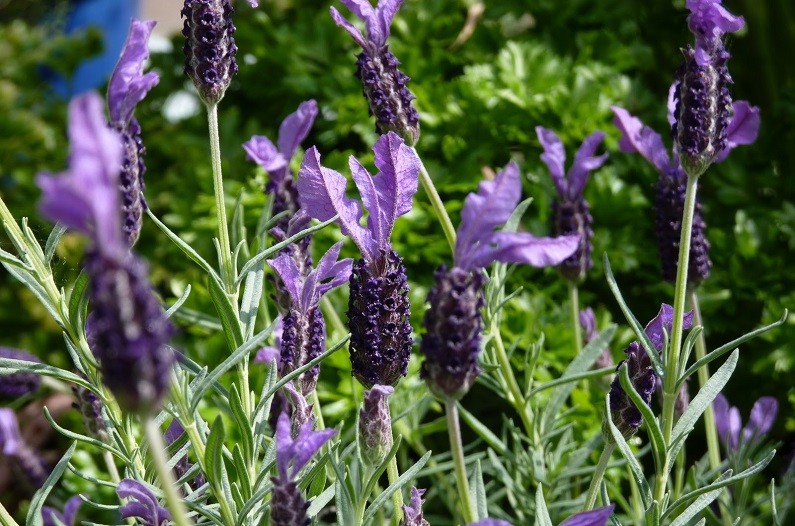
How to grow lavender from seeds
You can grow lavender from seeds at home, the plant is unpretentious, but you still have to follow the basic rules of care and planting.
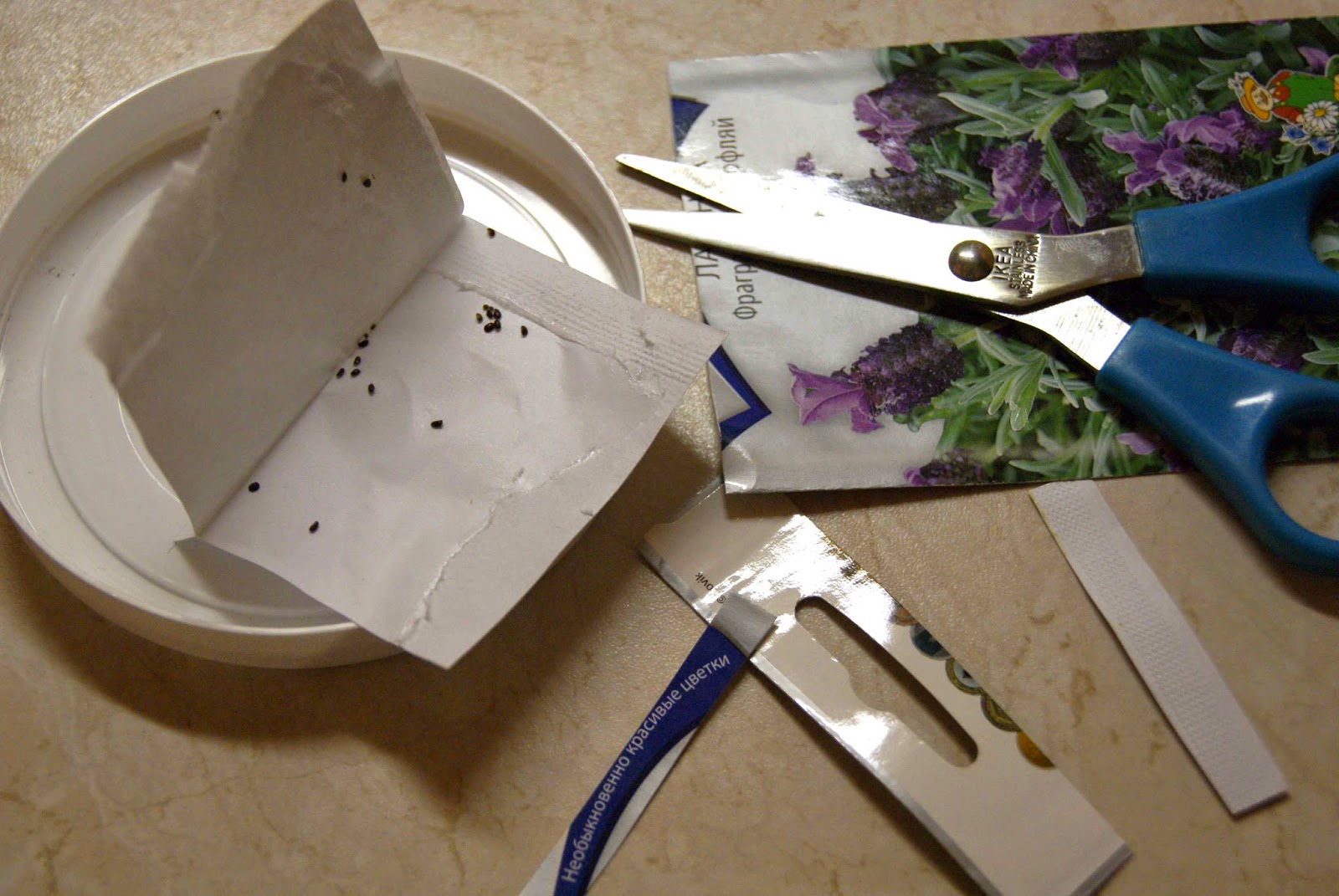
You can buy plant seeds at any store, and you can choose any variety of this plant. Of course, not every type of lavender can be grown on the site and at home, it is best to start practicing with growing narrow-leaved lavender. Buy seeds from autumn or winter. Why is that? The fact is that each planting material must be prepared before sowing, and this takes a lot of time.
To increase the germination of seeds, they must be kept at a certain temperature (from +5 ° C). This preparation is called "artificial stratification", the seeds are simply stored in the bottom drawer in the refrigerator. Why artificial? For natural hardening of seeds (planted in the ground and left for the winter), the climate of Russia is too harsh and the seeds can simply freeze. Therefore, it is necessary to harden planting material at home. To do this, the seeds are mixed with sand (only clean and sifted), poured into a container or into a tight plastic bag and placed on the bottom shelf of the refrigerator or in a box for storing vegetables for 2-3 months. After such exposure, the seeds can be sown in pre-prepared boxes with soil or directly into the greenhouse.
If you plant lavender seeds, then only a year later the first flowers will appear. So at first the plant will develop and build up the root system, and only after a year, or maybe even after two, the plant will delight you with its flowering.
Lavender. Growing conditions
Consider two ways to grow lavender: from seeds and planting seedlings directly in open ground. The option of planting seeds in pots on the windowsill is considered reliable.
How to prepare seeds, you already know. Now you need to prepare the soil for planting and pots (you can use boxes or adapt any containers). We will prepare the soil for planting ourselves, so you can be sure of the quality. Take 3 parts of the earth (best of all garden) and mix with humus (2 parts) and 1 part of sand (clean and sifted, best of all river). The resulting mixture must be sieved through a sieve so that the soil is not dense and without lumps. It is best to pre-treat the soil - calcined in the oven at a temperature of 110 ° C, you can steam it. If you can’t do this, then you need to water the soil with a weak manganese solution.
Prepared seeds (exposure 1-2 months) in late February - early March are sown in a container with soil. Just do not forget to provide drainage in each pot or box, lay a thin layer of sand (up to 3 mm) on top of the drainage layer, then soil and seeds can be sown. From above, crush the earth with a thin layer of sand. The containers should be covered with plastic wrap and placed in a warm and bright place. Periodically, you need to open the film so that the seedlings are ventilated. The temperature in the room should not be lower than +15 ° C, but not higher than +22 ° C.
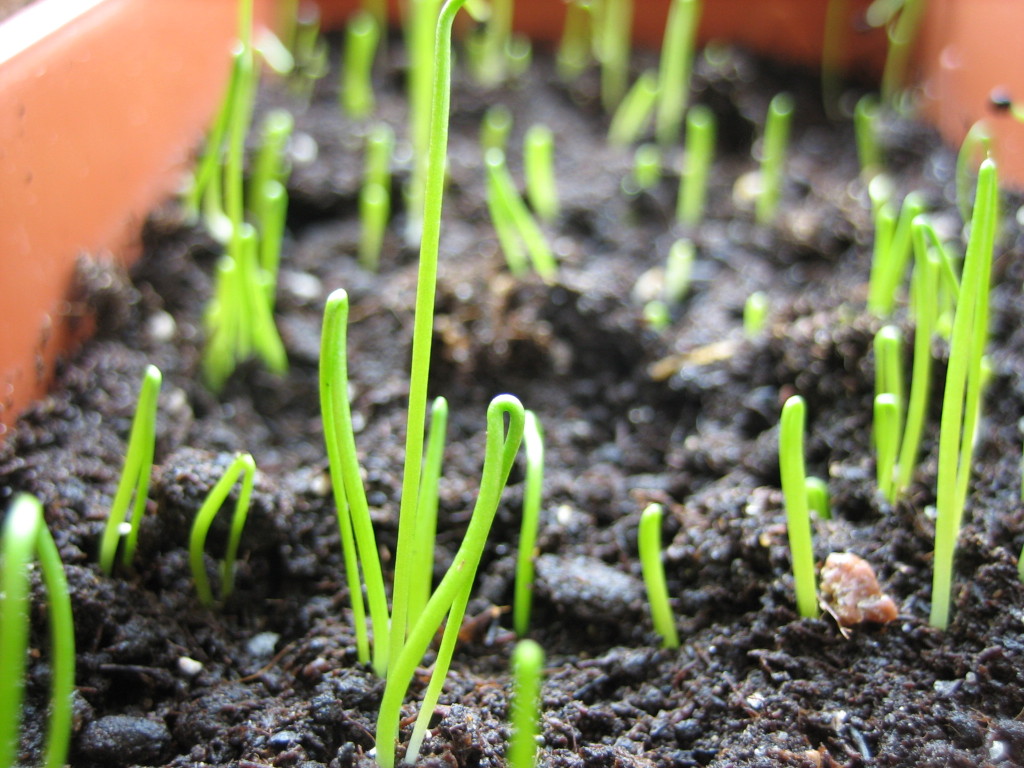
As soon as shoots appear, you can put boxes with seedlings of lavender on the windowsill and provide additional lighting so that the seedlings do not stretch. The film can be removed first for 30 minutes a day, after a couple of days - for an hour, and then completely removed.
As soon as the seedlings get stronger, you can transplant it to a permanent place in a separate pot.
There is another way to grow seedlings - to sow seeds in open ground. First you need to wait until the first shoots appear, but before that it is important to follow certain rules.
How to grow lavender in the country:
- landing site preparation. We choose a sunny and dry area, since lavender does not like moisture and dampness. By the way, keep in mind that the plant does not like transplanting, so you need to immediately choose a good place and do not transplant lavender;
- soil preparation: first you need to dig the entire area, add river sand to the soil (fine gravel is possible) to improve air circulation and increase moisture permeability;
- you can sow seeds in open ground in October (for residents of the southern regions). Depth 4 mm, the soil after planting needs to be slightly compacted. If it is dry, then immediately after planting, the seeds are allowed to be watered, but not abundantly;
- as soon as it gets colder and snow falls, it is necessary to throw more snow on the area where the lavender is planted;
- expect the first shoots at the beginning of summer or at the end of May, if the spring turned out to be warm;
- seeds may appear much later, so do not rush to dig up the site;
- young seedlings love moderate watering, it is impossible to flood the site;
- make sure that the soil does not dry out;
- as soon as the first inflorescences appear (in open ground, as well as when growing lavender from seeds in pots), they must be removed so that the plant gets stronger;
- since lavender will grow very slowly in the first year, it is necessary to ensure that weeds do not interfere with growth. It must be removed in a timely manner;
- by the way, lavender really does not like dampness and moisture, as well as acidic soils;
- for wintering, bushes of young lavender should be covered with oak leaves (they do not rot), and on top you can lay spruce branches made of coniferous wood. Do not cover plants with polyethylene, as they can ban;
- next year, lavender will no longer need to be covered;
- lavender, regardless of age, wakes up very late after hibernation. It may seem to you that she is frozen, but she is not. Wait, soon the first green leaves will appear on the stems, and soon fragrant flowers will appear.
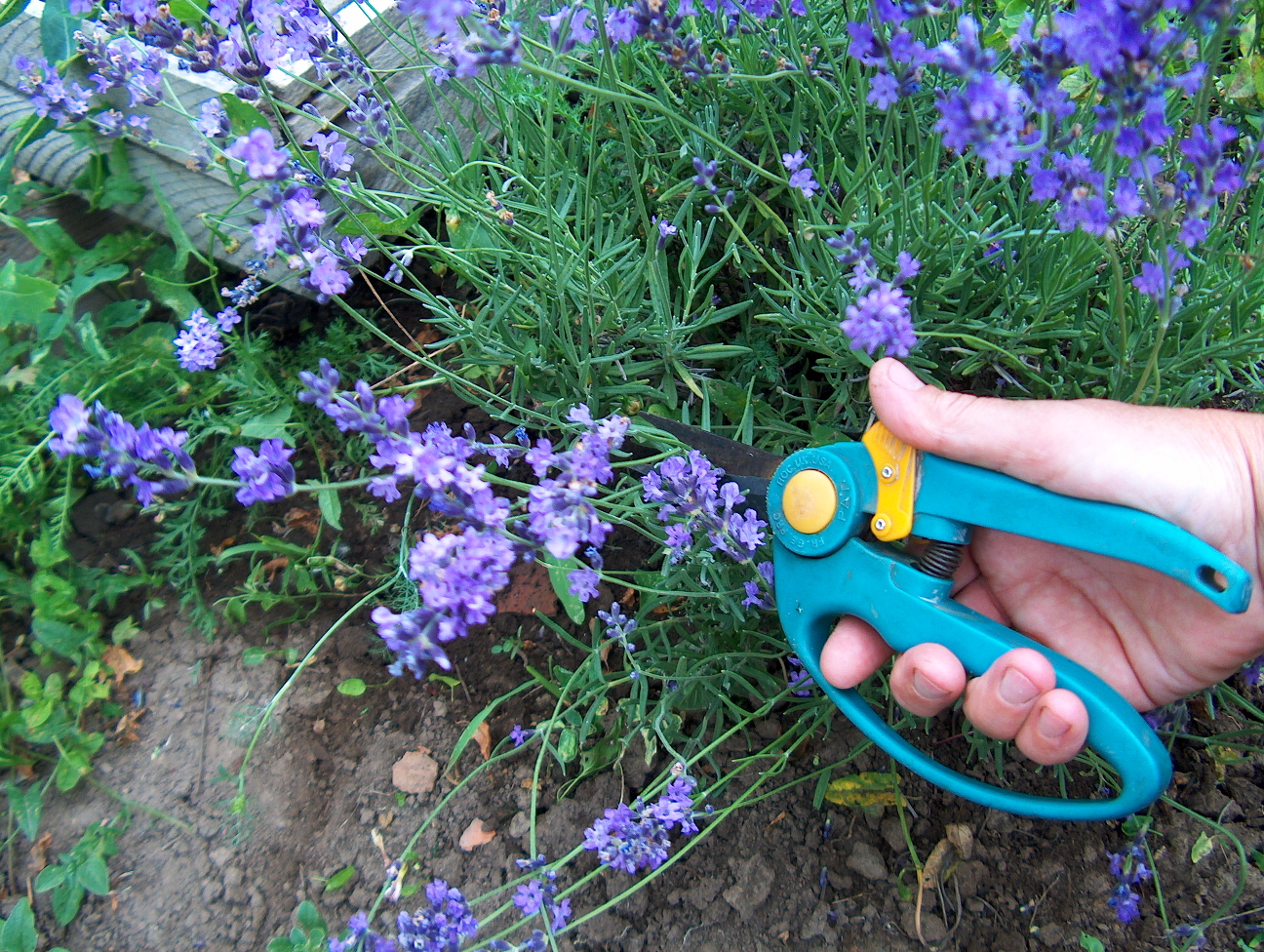
How to grow lavender at home
Growing lavender from seeds is not as difficult as it might seem, with a little patience you will be fine!
We study the growing process in more detail:
- We go to the store to buy lavender seeds.
- We mix the planting material with clean river sand, wrap it in plastic wrap and send it to the refrigerator for storage (we put it in a box for vegetables).
- Seed hardening can be done in another way: take cosmetic cotton pads, moisten each disk, put seeds, cover with a second disk. Place both discs carefully in a ziplock bag and store in the refrigerator. Every 3-4 days you need to open the bag for 1-2 minutes to air the seeds.
- After 2 months, the seeds can be taken out, a pot (at least 2 liters in volume) and soil can be prepared.
- Soil Requirements: This can be a mixture of peat and sand, you can add a little vermiculite and perlite, as well as crushed egg shells to make a mixture with a slight alkaline reaction.
- In a month you will see the first leaves, and when the plant reaches the growth of 6 pairs of young leaves, then the top must be removed so that the plant bushes well.
- Watering young plants should be soft and moderate. It is best to water lavender in the morning and in the evening, little by little. You can irrigate the green parts of the plant with a spray bottle. Don't forget to feed.
- Lighting - at least 9-10 hours a day, so you need to organize artificial lighting in advance. It is especially important to illuminate the lavender on cloudy days and in the evening.
- Make sure that the leaves do not burn in the sun if you put the pot of plants on the windowsill.
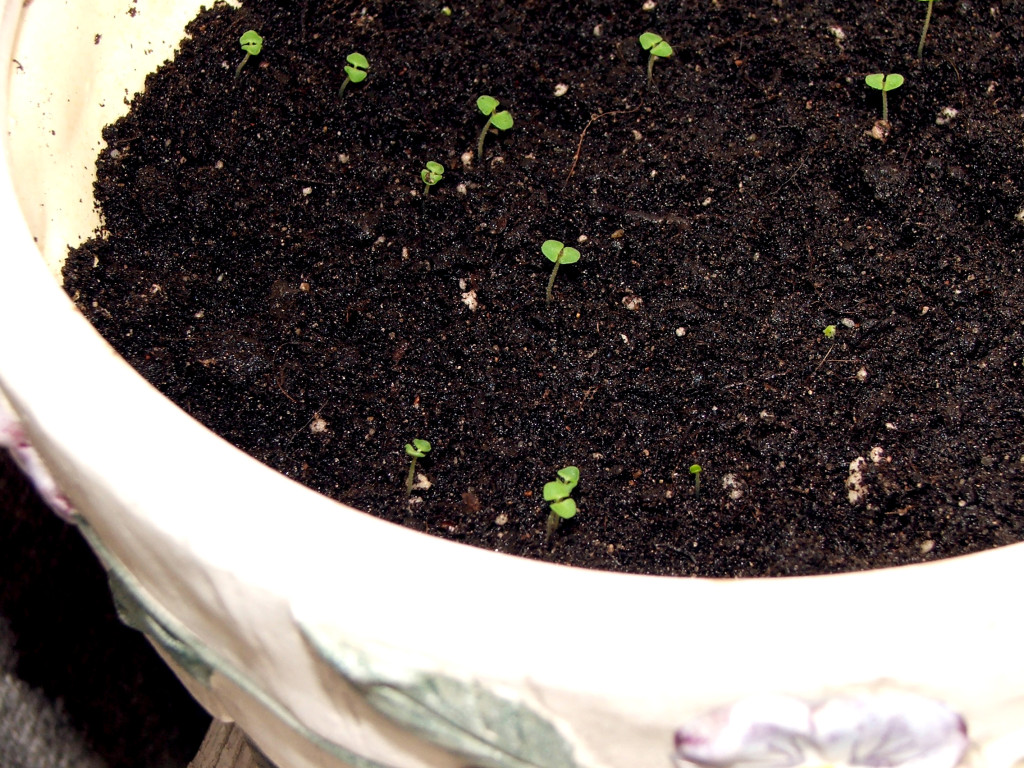
In the first year after planting, lavender will be weak and unsightly, don't worry. The plant needs time to mature. In the second year of life, the first flowers will appear, during this period you should try to avoid drafts, but you should not refuse to air the lavender.
A year after sowing the seeds, young plants must be cut so that the growth of lavender is no more than 15 cm, then you will get a neat, dense and beautiful bush. By the way, after the lavender has faded, you need to prune again.
In winter, you need the lavender to rest, transfer the pot with the plant to the glazed loggia, the temperature in the room should not fall below +5 o C.
If necessary, transplanting a stronger plant can be done only after 1.5 years, in spring or autumn, so that lavender has time to take root in a new place before the flowering period.
An adult plant can be propagated from air layer. To do this, the branch must be tilted and placed on the ground so that it lies horizontally, and then sprinkled with earth. You need to put something on top so that the branch is pressed down (you can use a stone). After a couple of months, under certain conditions (it is necessary that the soil is always wet), the cuttings of the plant will soon take root, and it can be cut off from an adult plant to transplant.
You can do otherwise and break off a stiffened cutting from an adult plant or several branches to plant in the ground. You just need to insert a branch into the ground and pour water. That's all, and with the onset of spring, you will soon grow a lush bush from one branch, which will delight you with flowering in the summer.
The topic of our article (“Lavender: planting and leaving in the suburbs”) is of interest not only to those who are just starting to communicate with the world of flowers. Even experienced gardeners need information in order to properly behave in the process of communicating with a particular plant. Before planting lavender, you need to carefully study all the features of this procedure, as well as the basic requirements for caring for a flower. As a result, the whole process will be completed successfully, and you will receive a reward in the form of a beautiful flower bed for the envy of everyone around you.
general description
As for such a species as planting and caring for this flower in the Moscow region do not differ from these processes in other regions of Russia. The principle of action is the same. But first, let's take a look at general characteristics plants. Lavender has won a strong place for itself both in the field of landscape design and in light industry in the manufacture of perfumery water, fresheners, gel, etc. The plant came to us from the Mediterranean and has about 30 varieties. Plants such as mint, rosemary, thyme are its direct relatives. Delicate pleasant aroma will not leave anyone indifferent, and purple flowers delight the eye of everyone who sees them. The plant itself has a narrow trunk with narrow greenish-gray leaves. The buds are collected in an inflorescence that blooms from June to August. Interestingly, even when dried, the flowers retain their ability to scent, and they are highly valued for this ability.
Different types
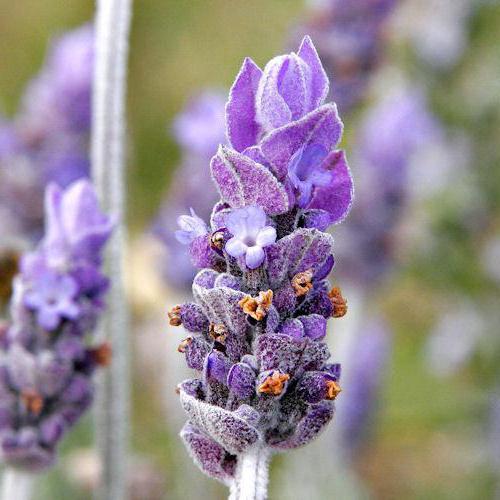 Whether lavender grows in the Moscow region or in another region, it needs proper care everywhere. Convenient is the fact that all plant varieties require the same set of measures. Despite the large number of species, only a few varieties of lavender are found in our gardens:
Whether lavender grows in the Moscow region or in another region, it needs proper care everywhere. Convenient is the fact that all plant varieties require the same set of measures. Despite the large number of species, only a few varieties of lavender are found in our gardens:
- "English lavender". A bush with narrow leaves that grows up to a meter in diameter, tolerates winter well, has an unpretentious character, and blooms in mid-summer.
- "French Lavender". In this species, the leaves have a bright shade and a wide shape. The buds are also several tones lighter than other species, and the smell is particularly harsh.
- "Dutch Lavender". This plant is very similar to the previous two, but can reach two meters in height.
- "Jagged Lavender". Silver leaves and buds with a lilac tint distinguish it from relatives, besides, it mainly grows indoors, and does not take root very well in open ground.
Lavender: planting and care in the open field
Many of us have heard a song about this mountain flower. He loves mountains, which means he absolutely cannot stand high humidity. The peculiarity of its roots gives the flower the ability to absorb moisture deep from the ground. When choosing a place to plant your lavender, consider this point, as well as the fact that it prefers loose soil and plenty of sun. Shade will work too, but you won't be able to see the full bloom of the plant. If it so happens that you have very wet ground in your garden, and the site is in a lowland, make a small hill and plant a flower there. As for the quality of the soil, avoid planting lavender in an area with high acidity, and if there is no other way out, then take care of neutralizing the soil with a lime mortar.
Before planting the plant, you need to add compost to the soil to loosen the soil and add fertility. It is recommended to plant a flower near the borders, where they will look very good. Plant bushes so that the distance between them is the same as the height of an adult plant. In this case, such a flower bed looks well-groomed, and it will be easier for you to look after each of them.
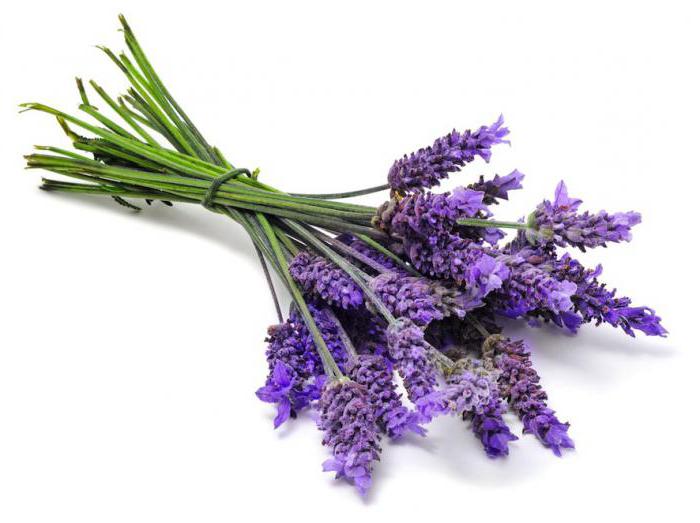
reproduction
Information on how lavender is grown (planting and care in the Moscow region), photos and descriptions of the plant are needed in order to ensure proper care for it. One of the important points is reproduction. The fact is that the plant does not like transplants, and if you had to resort to such a process, then you need to do it together with a huge lump of soil. This is done only if it is necessary to move the bush without fail. If you just want to propagate the plant, then there are several options:
- The division of the bush. In the presence of an adult plant, it is necessary to pour the mother bush in the spring to separate the layering. Then, with the advent of autumn, they can be completely separated and planted in other places.
- The use of cuttings. Also in the spring, you need to cut the cuttings about ten centimeters long and place them in the ground under the film, creating the effect of a greenhouse. Regularly watering and airing, we wait for autumn, when the cuttings can already be planted in the chosen place in the flower bed.
- The use of offsets. With the arrival of spring, bend down the lavender shoot and sprinkle it with earth in one place. When autumn comes, roots will already grow in this place, and it can be separated and transplanted to a permanent place.
- Sowing seeds. This method can only be used by an experienced gardener. A couple of months before the intended planting, the seeds are placed in a container with sand, which is constantly moistened, and placed in a cool place. The temperature of the content should be from two degrees of heat to four degrees of frost. In early spring, seeds are sown in open ground. After planting, the soil is well trampled down and watered abundantly. But this method is only suitable for a mild climate, as in the suburbs. But in regions with a more severe climate, this breeding option is doomed to failure, and the seeds most likely will not sprout.
Watering mode
Do not forget about the features of watering, which requires lavender. Planting and caring for this plant in the garden does not require much effort, but you need to know what this miracle of flora wants from you. Lavender should be watered only when the ground under the bush is completely dry. She prefers dry soil rather than waterlogging. If you notice that the leaves of the plant have begun to turn yellow, this means that you water it too often, and the root system has begun to rot. A very important factor in care is loosening the earth. Lavender needs air, so every time after watering or rain, you need to loosen the soil so that oxygen can freely get to the roots. To facilitate the work, you can apply mulching with peat or humus.
Application of fertilizers
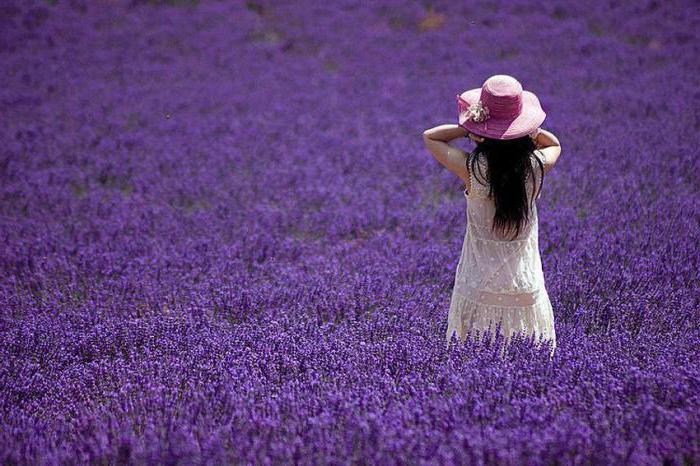
It is impossible not to mention the use of fertilizers when discussing the topic "Lavender: planting and care." A photo of a plant during the flowering period suggests that such a luxurious look requires additional help in the form of top dressing. Of course, lavender can do without additional support, taking what is available from the ground, but if you want to see the flower in all its glory, then do not be too lazy to apply fertilizer with nitrogen in early spring. This will give the flower the strength to grow a lot of greenery. Further fertilizers are applied only during the flowering period.
Bush formation
This procedure is optional. Even if you do not take part in the formation of the bush, it will still grow and bloom. If you want to have bushes larger and fluffier, you will need to resort to circumcision. To do this, first wait for the flowering period to end and all the flowers to dry. Before the cold period sets in, you need to cut each branch a couple of centimeters. Do not prune any more, otherwise the entire bush may die over the winter.
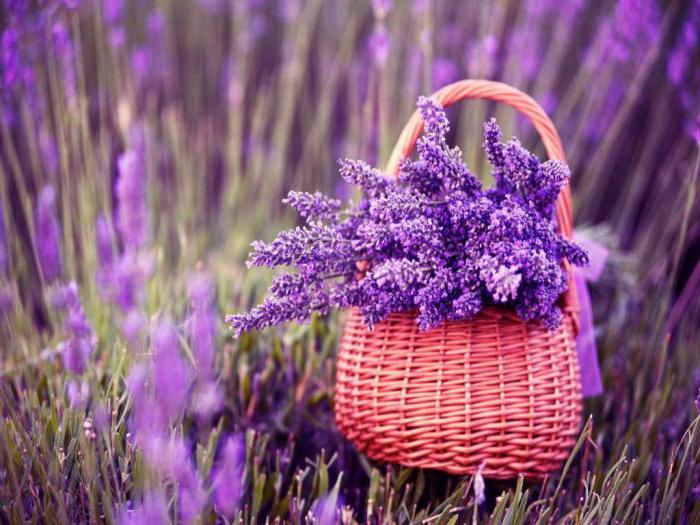
Possible problems
There are also difficulties that arise when growing a flower such as lavender. Planting and care in the Moscow region, reviews of gardeners about these processes - everything suggests that the flower takes root perfectly in this region and does not create any particular difficulties in care. It tolerates cold well and is rarely attacked by diseases or pests. But still there are times when the plant begins to suffer from some kind of ailment. In case of incorrect watering, rot attacks the lavender. The worst thing is that it cannot be cured, but you only need to destroy the flower, and quickly, until it infects nearby growing plants. All bushes affected by rot must be burned away from the flower bed. Also, lavender can attract insects such as the rainbow beetle. But it is rare and in small quantities, so it is easy to collect by hand.
How to Prepare for Winter Lavender
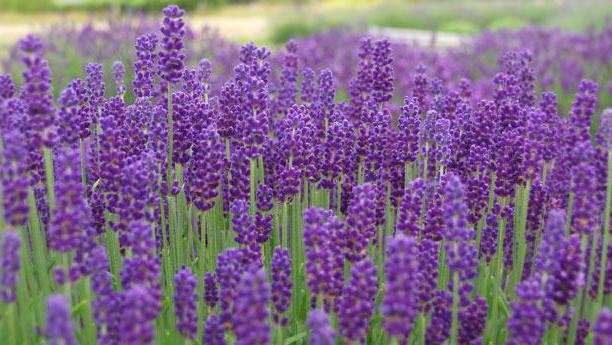
Planting and care in the Moscow region of this plant includes preparation for the winter period. We have already said that the flower is resistant to frost. He can tolerate temperatures up to twenty-five degrees below zero, and this quality is very valuable for such beauty. But we still do not recommend taking risks, and recommends covering the bushes for the winter. Branches of coniferous trees will be an ideal shelter. They pass air well and do not allow snow to fill up the bushes. For this purpose, foliage that has fallen from trees or grapes is not suitable, since under them the flower will rot and, most likely, will die. If you live in a region with mild winters, then you do not need to cover the bushes.
plant harmony
Sometimes people think about what lavender is combined with. Planting and caring for this flower in the Moscow region often entails the need to plant another flower. This is done mainly for landscape design. Planting the plant along a border, path, or hedge allows it to be combined with flowers such as rose, hydrangea, or sage. Considering color scheme lavender, it is recommended to use orange or red rosebuds, and in the company of hydrangea, the flower will look perfect on an alpine hill. Lavender looks very beneficial in a flower pot. If you plant just one lavender in a large area, you can only enjoy the view of its beautiful purple bushes. It is with this purple carpet with a wonderful aroma that you can surprise your guests, and they will be able to see in all its glory how lavender can bloom. Planting and caring for this flower in the Moscow region is not too difficult.
Scope of the plant
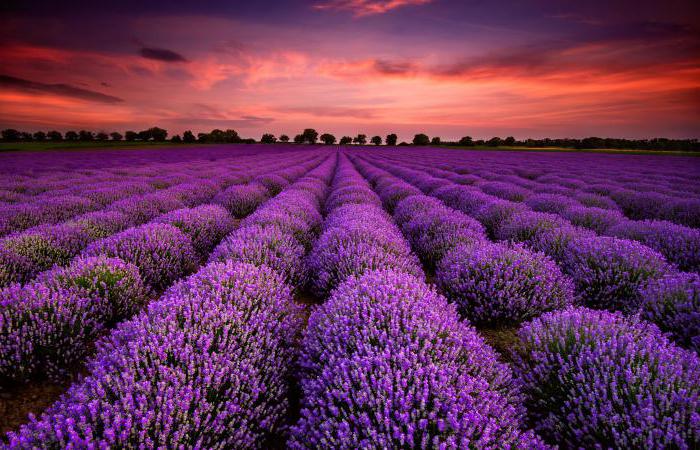
As already mentioned, the flower has an incredible aroma, which makes it attractive in this particular area. Firstly, it is used to add to tea, drinks, spices for meat and vegetable dishes. Secondly, an excellent essential oil is made from lavender, and it is used both in cosmetology and in medicine. From a medical point of view, the flower has a calming effect, eliminates insomnia, relieves fatigue. For cosmetics, there are no limits to the use of this fragrance. We observe its presence in soaps, gels, perfumes, eau de toilette, fresheners and much more. This smell has won the hearts of both the female and male half of the world's population.
Lavender blooms with beautiful purple flowers and smells divine. Due to its beauty and its useful qualities, it is grown in the garden and at home, used in medicine or in cooking. The most important advantage of this plant is that it is very unpretentious.
Types of lavender
There are three main types of lavender: English, French and Spanish. English lavender is the most popular and can be found all over the world.
What all gardeners need to know about lavender:
- Lavender prefers to grow in sunny places. The soil should be sandy and not too wet. Excessive soil moisture leads to rotting of the plant's roots.
How to plant lavender?
Lavender can be grown from a cutting that can be taken from any potted or wild lavender species. You can try to grow the plant from seeds, but in this case, flowering may not be very good. Lavender is grown in the garden in the garden or at home in a pot.
Before planting, the soil should be mixed with sand or gravel.
When is the best time to plant lavender?
Lavender is best planted in summer. This is due to the fact that the plant needs a lot of sunlight. If you choose to grow it at home, place your lavender on a sunny windowsill.
Plants do not survive in the shade. However, if you live in a region with a very hot climate, plants should be placed in the shade or out of the sun in the afternoon to protect them from leaf scorch.
Which soil type to choose?
Dry, sandy and alkaline soils are most preferred. Since lavender is a drought tolerant plant, it does not need soil that retains moisture for a long time. To make the soil drier, it is recommended to mix it with sand.
How should lavender be watered?
Lavender does not need abundant watering. It can be watered no more than three times a week. Feel the soil and if it's still damp, don't water it yet.
Too much moisture will cause the plant to rot. However, despite the fact that lavender easily withstands dry and hot weather, with a lack of watering, it can dry out. Therefore, the plant must be watered, but do it sparingly.
1. Lavender is little damaged by pests, so there is no need to treat it from them. If the weather is too humid, fungus may appear on the plant. If you avoid excessive soil moisture, you can avoid it.2.
It is better to prune lavender in autumn or spring, starting from the second year. Trim branches no more than a third of the height of the plant. Do not cut all the branches completely, especially the old stiff parts, as their damage may affect the growth of the plant.3.
Apply potash fertilizers in spring and summer. If the plant begins to turn yellow, this indicates that there is an imbalance in the level of soil acidity. The problem can be solved by adding compost.4.
Lavender prefers windy places. Caring for lavender does not require special knowledge or gardening skills. In order for this plant to delight you with its flowering, the information contained in this article is enough. Kalpana Kumari © site Kingdom of fragrances We wish you good luck, good health and well-being!
Growing lavender in your garden
Growing lavender beautify your garden and make it more fragrant. Plant lavender in your garden - a bush with grayish green small leaves. Lavender flowers are small, so the beauty of lavender is difficult to compete with a rose.
However, many gardeners are happy to grow lavender in their garden.
What is attractive about growing lavender?
Group planting of lavenders along the paths is a very beautiful sight. Lavender bushes are compact and dense. Flowers are located at the ends of the shoots. When lavender blooms, it looks like a purple or blue river flows along the path.
Different varieties of lavender have a height of 30 cm to 130 cm and above. It can be used for rock garden, border, hedge. The smell of lavender flowers is very pleasant, which spreads throughout the garden. Lavender has healing properties, which is why it is so popular in gardens.
Lavender is even used as a seasoning in the kitchen, adding to sweet dishes, juices, flour products. The aroma of lavender can be used to grill meat. Lavender descended into the gardens from the mountains. Therefore, it can grow in temperate and warm climates.
Lavender is distinguished by excellent properties, such as durability, drought resistance, delicate aroma and long flowering periods. There are about 30 types of lavender. Lavender flowers, white, pink, purple, blue, blue, violet.
Lavender narrow-leaved Lavandula angustifolia or officinalis
The most popular lavender is narrow-leaved Lavandula angustifolia or officinalis. It is also called English. Varieties of this type of lavender can grow in zones 5-8. Lavender angustifolia is an evergreen shrub. Height reaches 80 cm.
Lavender blooms from June to July. Flowers are tall erect racemes of small flowers 20 cm long.
Lavender French (Spanish) - broad-leaved Lavandula latifolia
Lavender French (Spanish) - broad-leaved Lavandula latifolia, blooms earlier than other types of lavender. It can be grown in zones south of 8. It is a tall shrub up to 130 cm tall. Flowering stems up to 50 cm long form 10 cm inflorescences.
Serrated lavender Lavandula dentata
Lavender serrated Lavandula dentata has a decorative appearance. This is a heat-loving plant, of small height with silvery carved leaves. It blooms with larger flowers than other species.
Hybrid varieties of lavender have been developed that are superior in aroma to natural types of lavender. Their smell is sharper. Lavender hybrids are called Lavandins Lavandins. In order for lavender to take root well in your garden, use varieties of local selection.
What soil to plant lavender in?
Lavender of all kinds prefers well-drained soils. It grows rapidly on sandy, loamy dry alkaline soils. Soil acidity pH 6.5 7.5. If you have acidic soils in your garden, then they must be neutralized to plant lavender.
For this purpose, use ground limestone. If the soil is too alkaline, then lavender will not be able to get nutrients from the soil. Therefore, compost is added to improve the soil. Soil fertility is average.
Before planting, add a handful of bone meal and compost in equal proportions. Choose a sunny place for lavender, here it will bloom better, the aroma will be stronger. The site for planting lavender should be cleared of weeds, as weeds quickly drown it out.
When to plant lavender?
Lavender is planted in the spring after the last frost. In climate zone 8 and above, lavender can be planted in autumn 2 months before the onset of cold weather.
planting lavender
Before planting lavender, put it in water for 1 hour. It is best to plant lavender on elevated beds 30-40 cm. Before planting lavender, cut off its top so that it bushes better. The depth of the pit for planting medium-sized lavender should be at least 30 cm. The distance between bushes is 30-40 cm. If you plant tall lavender 3 m, then the distance between bushes is at least 90-120 cm.
Lavender care
Lavender prefers dry water conditions. If the climate is very dry, then lavender requires periodic watering. It is only important to water if the ground is dry to a depth of 6.3 cm.
The frequency of watering is reduced in autumn and winter. The soil near the lavender bushes is periodically loosened to improve air permeability. To prevent the growth of weeds, the soil is mulched with light materials: sand, gravel or shells. After flowering, the lavender is cut off.
The English have an interesting way of remembering how to prune lavender 888. This means that on the 8th day of the 8th month (August), cut the top shoots up to 8 inches (20 cm) from the ground. Then you do not need to prune lavender in the spring. Now you know how to plant lavender in your garden.
We are sure that you too will feel the fragrant magic of this humble flower.
How to grow lavender in the country
Lavender is a very demanding plant and without proper care it will not bloom. But with proper care of this plant, a fragrant lilac carpet of flowers will delight your eyes for more than one season.
In addition to spectacular appearance, lavender is widely used in medicine, cosmetology, interior decor. The aroma of lavender has sedative properties and relieves headaches. Dried lavender sprigs protect clothes from moths and fill the house with a delicate aroma. In today's article, we will talk about how to grow lavender and what kind of care lavender bushes need.
Suitable place to land
At the summer cottage, lavender should be placed along the curb, paths, or on an alpine hill. For planting lavender, you need to choose open areas that are well lit by sunlight. Of course, the bushes will be able to take root in the shade, but it will not be possible to achieve “carpet” flowering there.
Optimal temperature
If you live in a region with a rather cold climate zone, then lavender should not be planted in the ground, but in a large flowerpot or capsho, this is done in order to effortlessly transfer the plant to a secluded warm place during a sharp cold snap.
Watering
Lavender does not respond well to extremes - the soil should not be allowed to dry out too much, but lavender should also not be flooded with water, as its roots are very sensitive to dampness and may die. The fact is that with excessive soil moisture, the rhizome can simply rot, and after that the plant cannot be restored.
Fertilization
During the flowering period, fertilization is indispensable. To begin with, it is necessary to apply mineral fertilizers, for this, a couple of tablespoons of the concentrate are diluted in a bucket of water, you just need to pour the mixture over the lavender bushes. You also need to remember about nitrogen and organic fertilizers, you need to be careful with them, as they cause rapid growth, not flowering.
pruning lavender
Lavender pruning is usually done to form beautiful and even bushes. This plant often grows very heterogeneously, and in order to have the effect of a “lavender carpet”, shoots that are too large should be cut off. An additional "haircut" must be carried out after the inflorescences have faded.
Reproduction of lavender
There are three main ways to propagate lavender bushes: cuttings, planting seeds, and dividing the bush.
Reproduction of lavender cuttings
Planting lavender cuttings is one of the most simple ways, you just need to root them a couple of centimeters in moist soil, cover with oilcloth or glass to create a warm microclimate, and wait until the cuttings germinate.
Planting lavender seeds
This process is very laborious, because gardeners use it extremely rarely. First, the seeds are placed in the refrigerator for a month, and then they are planted for seedlings in boxes. It is necessary to keep such containers at a certain temperature, from +16 to +21? C. After germination, seedlings are planted in the garden, but flowers should not be expected until next year.
Reproduction by dividing the bush
By autumn, large lavender bushes are dug up and divided, but for this, in the summer, you need to choose suitable representatives. First, the plant should be cut so that all the space between the stems is filled. By autumn, the bush should be dug up and divided into two parts, each of the halves will be a separate bush.
Popular types of lavender
There are about 30 types of lavender found in nature. We will focus on a few of the most common and popular types.
Lavender angustifolia or English
Lavender angustifolia is a large shrub that reaches a size of up to one meter in height and a meter in diameter. The leaves are small and narrow, gray-green in color. It has a strong odor, especially during the flowering period from June to July.
In care, this is one of the most unpretentious varieties, moreover, it is resistant to low temperatures.
Lavender dutch hybrid
Less hardy than English narrow-leaved lavender. The height of the bush can reach two meters in height, which is why it is used in industry in Europe. It blooms in large inflorescences on long stems, the beginning of flowering is in July.
Lavender jagged
This variety of lavender in our climatic conditions is grown only indoors, because it is very thermophilic. Scalloped lavender is very decorative thanks to beautiful leaves silvery and large flowers of different shades of blue.
lavender broadleaf
Broad-leaved lavender is the ancestor of decorative varieties. In addition to its high decorative qualities, it is one of the most hardy and undemanding, thanks to which it has earned popularity among gardeners. Flowering begins in May, has a strong (not always pleasant) smell.
Comments Add commentsHide commentsHide comments
Potentilla: planting, proper care and propagation of the bushSecrets proper care for garden jasmine Rudbeckia: how to properly care for a flower
Most Popular Articles
Summer Menu: Best Zucchini Recipes
See also: garden
Lavender care at home
Lavender is an essential oil crop that grows as an evergreen shrub. The species of this plant are numerous. The lavender flower has a root that penetrates the earth to a depth of four meters.
Its aerial part rises above the soil surface by sixty to eighty centimeters. The crown of the flower is formed by numerous branches forming a compact sphere. At the ends of the branches are flowers that are collected in spike-shaped inflorescences.
The leaves of this flower are sessile, lanceolate or linear, their entire edges are bent. Evergreen frost-resistant shrub lavender in nature grows in the Mediterranean, in India and the Canary Islands. When growing lavender, it is necessary to provide it with a lot of light and heat.
However, lavender is a very hardy plant, able to tolerate both drought and frost. Adult plants painlessly tolerate frosts down to -30C. Lavender will be fine with poor soil, but it should be light.
Lavender does not grow on heavy soils.
Materials on Lavender
In this section you will find posts on the care, cultivation, watering, propagation of Lavender. Community users share tips and secrets among themselves.
A huge number of photos. The purpose of our project is the exchange of experience so that each project participant can learn how to care for a plant at home. Register.
Lavender - garden attendant2
Having once planted lavender in my garden, I got rid of many problems. For example, aphids do not tolerate lavender at all. I plant it next to dahlias and roses. The ants avoid them. Everyone knows that dry lavender saves things in the closet from moths.
Lavender is very unpretentious. Can grow even on poor soils. However, not...
Features propagation of lavender cuttings2
Lavender is a rather unpretentious plant. As personal experience has shown, it is easiest to propagate it vegetatively. To do this, you need to prepare cuttings. To obtain a cutting, we select young shoots from full-fledged, well-developed plants.
We cut the cuttings with a knife with a sharp blade. We make the lower cut closer to the kidney to avoid rotting ....
Lavender cuttings2
For me, propagation of lavender by cuttings is the most inappropriate option. Unfortunately, many cuttings do not give roots at all or rot, putting in a couple of short roots. But still, the chance to grow lavender in this way is quite large.
To begin with, you need to remove all unnecessary leaves from the cuttings, exposing the lower part by at least 5 cm. Then be sure ...
Propagation of lavender by layering0
The surest way to get a lot of lavender seedlings is by layering. With this method, you do not have to fiddle with cuttings or prepare seeds. Everything is very simple. The lower branches are dug into the soil and fixed there with hooks or hairpins.
Most of all I like a slightly different technology of rooting layering. In the spring, when the bush wakes up, ...
Reproduction of lavender seeds0
Lavender, of course, is best propagated by layering or cuttings. But sowing seeds can also be successful. Just keep in mind that they need stratification. To do this, the seeds are sprinkled with soil and placed in a refrigerator or unheated room for a month or even a month and a half.
I went the other way, just planted lavender late in the fall. So...
Lavender in the garden1
Lavender belongs to the category of plants that love the sun very much. Therefore, in order for the flour to develop well, you need to choose a sunny open place for it. Although lavender can also put up with partial shade. But good watering is needed in any case.
Due to the drying of the soil, my first lavender bushes were bent. At the same time, overflow too...
Where to plant lavender0
Lavender is an aromatic plant. It fills the summer air with a delightful scent. To adequately appreciate the fragrance of lavender, you need to plant a plant next to the path or along the edge of the curb.
For this, dwarf plant varieties, such as Hidcote, are suitable. Lavender loves well-drained soil and a sunny location. On heavy ground...
Lavender sung in songs - cultivation features.3
Does everyone understand the song about lavender? So I remembered about it when I was presented with a bag of English-made seeds. Well, what can I say.
Firstly, it is not mountainous at all)), secondly, I did not find any special beauty in the flowers themselves, just a small inflorescence of a lilac hue on an elongated stem. Its beauty lies in...
Lavenderaa....4
Lavender appeared in our garden in ancient times, when the song of the same name became fashionable. My mother sowed it, and since those ancient times she has not left our flower garden. The landing site, however, was changed, but it was not completely abandoned.
Lavender does not tolerate acidic soils at all, this is the main condition for its planting. The plant develops well when sowing ...
Spices at home.2
Home grown lavender becomes an evergreen, fragrant, flowering and medicinal spice. This plant brings good luck. French lavender is best suited for the home. Pour pot shards or crushed stone mixed with sand into a flower pot with a diameter of 15-20 cm, then mix in equal proportions of garden soil, sand and earth ...
Vasilisa
Mountain lavender in my flower garden
Lavender is an evergreen plant. It does not grow wild in our area. Therefore, I bought one bush in the market and for the third year now it has been growing in my flower garden. I immediately thought - an unenviable bush for myself, let it grow for a change. But when it bloomed!
I was delighted with fragrant blue flowers! Planted in the sun, near the rose. Then I noticed that the rose...
Lavender protects the rose from pests
I love roses very much - even on March 8, my husband gives only these flowers. A few years ago I started growing them in my garden. The flower garden was fragrant and delighted us until pests appeared - aphids.
I was tormented to process my flowers and thought to abandon this business, as one very good friend advised me to plant lavender bushes near roses. This is...
How to grow lavender?2
There are 2 ways to grow lavender. 1) Take a cutting from the mother plant and plant it. This method will help to grow a plant faster and more reliably, getting an exact copy of the one you like.
2) Grow lavender from seeds. This method will help you grow more inexpensive plants, but the process itself is long and difficult. The first difficulty is finding...
Lavender angustifolia1
For a long time I wanted to grow narrow-leaved lavender in my backyard - I really like tea with lavender, but before that I always bought from old women who grow spices. This year I bought a bush, planted in the sun.
But for some reason it doesn’t bloom for me, although quite a lot of time has passed. I've already watered and...
The benefits of lavender.3
Although it is not very easy to grow lavender, I grow this plant in my country house. All the neighbors only say that lavender only scares away moths. But it can be used as a fragrant, even as a medicine.
For example, for headaches or insomnia, I put lavender in bed as a sedative. I also use flowers and...
How to plant lavender and how to care for it?
Lavender is a semi-shrub with a very strong root system. There is almost no stem. The beginning of branching at the very surface of the earth.
They are covered with grayish-brown bark. Every year, a lot of green twigs begin to grow anew, the height of which can reach up to 35 - 40 cm. The leaves are dense, linear - lanceolate, densely pubescent, the length is 2.5 - 6.5 cm, and the width is 1.2 - 5 mm .
Inflorescences are long, spike-shaped. Corolla has purple with different shades, most often pale - violet - lilac. Previously, lavender was used mainly to give linen a pleasant smell and to repel moths.
In addition, this plant was placed in bed pillows, as its aroma has a calming effect on headaches and insomnia. Today, lavender inflorescences are used to obtain essential oils that have found application in medicine and the perfume and cosmetic industry. Lavender oil can promote healing burns and wounds. With rheumatism, for rubbing, you can use its alcohol solution.
With palpitations and neurasthenia, as a sedative, you can drink tea from the leaves and flowers of lavender. With sore throat, you can rinse your mouth with a decoction. Flowers can be put in sauces, salads and main dishes. How to plant it and how to care for it?
Acidic soils, in which groundwater is close, are completely unbearable for lavender. The best place for its cultivation is a sunny, dry place with fertile soil. The soil reaction should be alkaline, and in some cases it should be limed.
Before planting, you need to add sand, humus and compost to the pit. Nowadays, mostly imported seeds are bought. They are sown in October, before winter, in rows with a distance of up to 50 - 60 cm. Lavender grows in one place for 20 years.
For the winter, it must be covered with coniferous branches or leaves. In the spring, it is fed with fertilizers: 1 tablespoon of urea or 2 tablespoons of liquid “Sodium Humate” is diluted in 10 liters of water, the consumption rate is 5-6 liters per 1 plant. 10 liters of water 2 tablespoons), 3-4 liters of solution are spent on a bush.